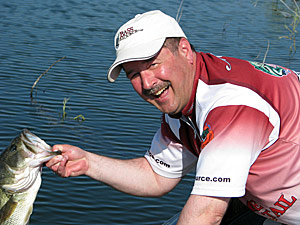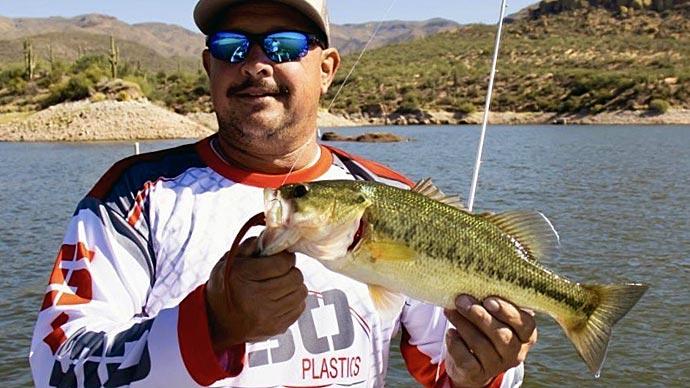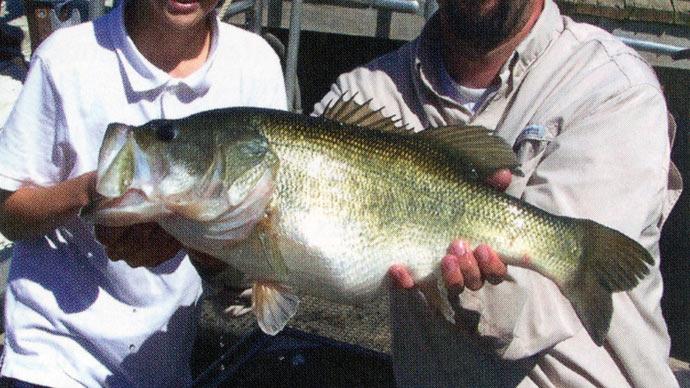
When I was a teenager (right after the last ice age), a sudden revolution began hitting the realm of bass fishing. A fellow who was originally from Ohio and subsequently had the good sense to move to Tyler, Texas, had invented a creature called a plastic worm. Mr. Nick Creme introduced the Scoundrel, which was a simple straight worm. Interestingly, after years of changes in soft plastic products, the fad of wacky or "do nothing" worms that struck a couple of years ago reinvented a different use for the same type of straight worm as offered initially by Mr. Creme.
Several of the fishing crowd that convoyed together from my hometown to some east Texas lake each weekend began to try to salvage the worms, whose heads had been damaged during a hookset or given way from too many casts with a Texas rig. The plan was to heat the plastic to a temperature where it fused but did not melt. This effort led to several of the bass fishing fraternity brothers being permanently banned from the kitchen work areas after they created an odor during these experiments that perfumed the entire house (or caused mass evacuation since everyone other than the worm repair specialist believed an electrical fire was in progress). Those hardy souls who found a way to control the melting rate of the damaged worms soon began to realize they could expand their creativity to more exotic creations. This resulted in worms being produced with multiple tails, small legs being extended from the bodies, and, my personal favorite, the presence of various chicken feathers extending out from the body of the worm. It ends up these guys were ahead of their time since, from then to now, soft plastics have been offered in all variations of body forms (except none, to my knowledge, have had chicken feathers added).
Some recent offerings allow you to add contrasting colors to soft plastics. These "stains" provide permanent color to the worm or lizard, with their only limitation being that the color is less evident in the darker soft plastic baits.
A friend who guides was really into "dipping" the tails of lizards or worms into his favorite chartreuse color. After a while, a client decided he wanted to try the same technique. Until then, the guide had dodged this issue by dipping for the clients. Unfortunately, before he could respond, the client had dipped the lizard's tail and kicked the small bottle over in the boat in haste to get the creation in the water. If you have ever wondered, this dip and dye product also permanently stains the carpet and the boat's gel coat. My comment, "gee, I thought you only stained the backs of things, yet your motor escaped," was not well received.
Another choice for modification of soft plastics is to use one of the "scents" available for spraying on the lures. Some companies have the "odors" embedded within the plastic, whereas others have less emphasis on inherent "strike stimulators." There are many spray-on or liquid forms to use on soft plastics. At least some seem to cause the fish to hold on longer, whereas some other odor additives probably do more to cover the scent of human odors than to give other food sensations to the fish.
There are certain chemicals living things are made of, which seem to be repulsive to fish. Some are neutral, and some are stimulatory as "odors" from desired food. All of the "odor" issues can be minimized if you are working a bait with a fast retrieve or if you are using crankbaits. In such cases, the importance of odor is of little value since the strike is triggered by visual or vibration components created by the bait.
It has always been the case with bass fishermen that an inherent instinct drives them to seek modifications that will make a lure even more desirable to the bass than when it was purchased or made. A simple case in point is the variety of variations you can make in a spinnerbait. The many choices of skirt colors, as well as blade combinations, can make the same bait much different in visibility as well as vibration on retrieve. This translates into an increased confidence level in the modified bait by the fisherman, and this often translates into more strikes. The modification of baits is significant to the strategy of those bass fishermen who think through all facets of their sport, particularly when deciding on the choice of baits, colors, and presentation styles for given fishing conditions.
Some straightforward modifications can be made to lures that can result in differences in visual appeal and enhancement of their action. For example, in the case of topwaters, a change of the balance point in chuggers and poppers can be achieved by adding additional weight to the rear. This can be achieved by adding a slightly oversized hook in the rear position. The extra weight makes the bait float in a more upright position and, when moved forward, tends to tilt over with minimal forward movement each time it is worked. This, of course, can induce strikes from a topwater plug because the bait can be worked more repetitiously in a small area, thus tending to agitate a strike reaction instinct.
Another type of action created in topwaters is one of a frightened food fish trying to attempt "escape" by a rapid darting and zigzag action. This approach results in a more rapid retrieval. However, even with this type of action, your best results occur when you try a stop-and-start technique between bursts of movement. You can add action to these retrieve styles if you put a pulsating trailer on the back hook. Bucktails are ideal for such trailers and provide little additional weight but make chuggers, poppers, or even a Zara Spook have additional tantalizing action even when the bait is setting still between movements.
Another minor modification that can add action to lures is either using a loop knot to attach the plug or a snap or an "O" ring. In any of these cases, the same result is achieved because you are essentially creating an unrestrained pivot point at the point of attachment to the plug. If you can achieve a more upright angle for a topwater if you add weight to the tail, then the logic is that you can do the opposite with a diving crankbait by adding weight to the front of the plug. By making the bait initially sit at a steeper angle at the front, you impact the angle of dive, which results in a more rapid and overall deeper dive on the retrieve.
Some weighted "stick-on" can be stuck on a lure's belly and affect the dive angle by placing more weight in the forward area. This will work without altering the bait's action as long as you place the weight in either the midline of the forward part of the belly of the bait or under the lip (again in the same midline of the two halves). Another use of the "stick-on" weights is to create a countdown bait out of a floating bait. Smithwick Rogues, Rapalas, and some other hard jerkbaits, now come in a countdown model, but creating a sinking or countdown plug in the past could be as simple as using oversized hooks. The downside of oversized hooks is that they are more prone to tangle on the cast but can help give you a countdown or suspending lure. The suspend modification is a nice feature since, under some conditions, you may trigger more strikes if the plug stays at a given depth for longer periods. For example, a suspend technique is most useful when fishing over suspended vegetation.
You may also recall a few years ago that one crankbait company put out a lure that had, as part of the instructions, an illustration of how you could change the dive angle by bending the lip. You were to heat the underside of the lip at a certain position and gently bend the forward portion downward using pliers to create a sharper angle. The concept worked in that, when done right, you could create a deeper dive angle, resulting in a deeper retrieve. However, if you over-bent the edge of the lip, you ruined the action totally, and the plug came in without wiggling.
One of the approaches that some guides have been using with crankbaits over the last several summers on Fork has been to "stroll" the baits. This consists of letting out a lot of line, engaging the reel, and putting the trolling motor on high. Yes, it is a modification of simply trolling with the outboard. But if you want to drive a diving crankbait down further than with a usual retrieve, then borrow a concept from the down-riggers of the northwest. Use a three-way swivel and tie a weight to the short drop-line with the longer leader tied to a snap on which you can place the crank. The advantage of using such a rig is that you are no longer required to get a maximum dive bait but can even use a shallow crank and get it down. If you have trouble with the concept, envision it as "drop-shotting" with a crankbait.
Another modification you can make to your favorite lure is to paint them in colors you like rather than be forced to use available colors. The logic for the colors in which baits are offered is an interesting issue in that the focus is more on catching fishermen in some cases than fish. Crankbaits became fashionable partly due to the success in tournaments following the introduction of Big O and Big N-type plugs. Most cranks were made from bone-colored plastics, and fishermen began to notice that the loss of surface coloration (which resulted in more and more bone being shown) did not result in less attractiveness to the bass. Under some conditions, the plugs seemed to be even more productive. This observation only occurred when new baits were bought, sanded, or scraped to the bone undercolor. Then some companies got sharp and offered a bone-colored bait.
Recently a lure designer for one of the fishing tackle giants told an interesting story. First, to give some background, this company is into rods, reels, lines, lures, and assorted associated products. They also have one of the country's strongest research groups in fishing technology. So when they release something and say it has been tested, you can believe it is tested. So when they introduced the line of crankbaits, I was fascinated by the colors they offered. Then I thought through the choices and realized we had taken things back a few years to the stage when the color selector device was being touted and lures in the color selector patterns were all the rage.
The colors they offered in the new crankbaits looked somewhat faded compared with most of their competitors' offerings in the same general tones. Guess what? These color tones were the ones the bass found most appealing in their test tanks. Unfortunately, the pale green did not turn the fishermen on, even though the bass voted for the color. So the company had to adjust their colors away from the most effective tones to ones that fishermen liked (go figure), and sales went up.
You can modify your favorite style of bait by painting the plugs yourself. A quick-dry spray paint such as Krylon or Rust-Oleum will do the trick. If you want to get fancy, use masking tape to cover the parts of the lure you do not want to paint with a given color.
To get fancy, make scales on the plug. Buy some self-adhesive fiberglass drywall joint tape to achieve this effect on a lure. Cut the tape to the form of the area on which you want to place the scales and spray away. After the paint dries, remove the tape, and you will have scales of the desired color. If you want to add some additional appeal to those colors that mimic shad, minnows, or bream, sprinkle some glitter onto the surface of the freshly painted bait, and it will stick.
By painting your lures, you may stumble into some old-new color that the fish have not seen for a while, such as bone. The other advantage of painting your crankbaits is that you can use closeouts or sales to buy baits in colors that are not fast sellers and are marked way down for fast sale. By the way, if you want to paint the baits with lighter colors, chartreuse, or other florescent tones, you will get the best results if you first paint the plug with off-white as a base coat.
Modification of lures can make them have more fish-catching appeal by making them more attractive, visible, or in some cases, "different" from anything the fish are constantly seeing. In either case, the fisherman adds his own touch to baits and, in doing so, can increase his confidence in the lure being presented to the bass.




